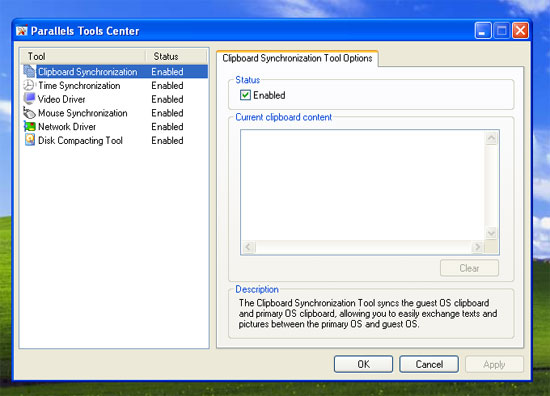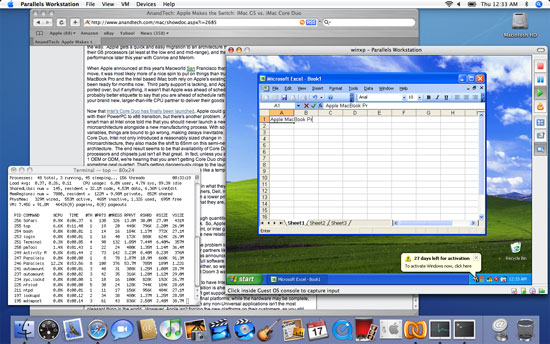Apple's MacBook Pro: Using it as a Mac and a PC
by Anand Lal Shimpi on April 13, 2006 12:00 AM EST- Posted in
- Mac
All of the things that wouldn't work on the keyboard in Boot Camp worked just fine in the VM. Ctrl clicking acted as a right mouse button and obviously all of my function keys worked. Parallels' Workstation also comes with a set of tools that you can install in Windows that enable additional functionality such as a clipboard synchronization tool. The sync tool makes it so that anything you copy in one OS is available to be pasted in the other and vice versa, making the VM truly behave like just another application running in OS X.

By far the biggest drawback of the Parallels' Workstation VM is that the GPU makers currently don't support any sort of GPU virtualization, meaning all of the graphics are CPU rendered when running the VM. What this translates to are choppy animations and a laggy mouse pointer when you're navigating around Windows XP; of course, don't even think about running any 3D games. There is a Parallels video driver bundled that is supposed to improve things, but you still get nowhere near the performance of hardware accelerated 2D graphics.
Update: While finishing up this article Parallels released beta 3 of their Workstation VMM for OS X, one of its improvements happened to be an increase in performance and an improved mouse synchronization tool. The updates in beta 3 made the mouse lag virtually disappear, which was a huge improvement over beta 2. The animations in Windows XP were still quite laggy unfortunately, but without a real GPU driver that's not going to change. Needless to say, the improvements in beta 3 make Parallels' solution far more interesting as an alternative to Boot Camp.

The CPU performance was quite good, although the VM only allows Windows XP to access a single core of the Core Duo processor. In the end, the fact that the MacBook Pro has two cores works out very well for use with a VM manager as the VM can use one of the cores while your other core handles whatever you may be doing in your host OS.
Overall running Windows XP as a VM using Parallels' Workstation is extremely convenient, but personally the choppy animations are annoying enough to the point where I'd almost rather use Boot Camp. I think my preference would change depending on what I needed to be in Windows XP to do. Currently my only needs for Windows XP are when I want to play a game or need IE for a particular website; the former would require Boot Camp while the latter is better suited for a VM solution.

One thing is for sure, the VM route does hold a great deal of potential for the future. Once virtualized graphics and I/O are here, the days of being stuck with a single OS on a single platform will be long gone.










52 Comments
View All Comments
Calin - Thursday, April 13, 2006 - link
This could be thanks to slower drivers in BootCamp Windows XP, or slower hard drive access/speed. Everything else is a disadvantage for VM: one more level of indirection in disk access, less memory, running the OS X behind the VM.Could you do some disk speed comparation between VM and native XP?
BigLan - Thursday, April 13, 2006 - link
I think it's going to be hard drive speed throwing off the benchmarks. The BootCamp partition is going to be at the outer edge of the disk, with much slower speeds than the VM client virtual drive which is on the faster Apple partition.I'm not sure if it's possible to assign the entire HD to a windows partition using Bootcamp, but that's about the only way i can think of to level the playing field.
Calin - Friday, April 14, 2006 - link
To nitpick, it would be at the center of the hard drive, not at the outer edge :) (ok, based on sector numbers, which starts at the edge).Near the "end" of the hard drive, the transfer speed is reduced (there are fewer bytes on a full circle).
jimmy43 - Thursday, April 13, 2006 - link
Excellent Review. This may be my first laptop purchase, seems to have everything I could possibly want.monsoon - Thursday, April 13, 2006 - link
Hello Anand,...i'm waiting for Parallels to finalize their VT release and maybe Merom Macs too...
I was wondering if the ONE CORE only VT tech is to be the final result of their virtualization software or just a middle-step.
Seems to me it's rather poor a solution ( ok, it's the best out there for now ) to use a dual-core computer to run both OS on a single core
=/
Better would be smart distribution of tasks to the CPU depending on which OS is actually under load...
...any thoughts / info on that ?
Thanks for your nice review !=)
plinden - Thursday, April 13, 2006 - link
Looking at CPU load while running Parallels VM, I see the load spread evenly over both processors (usually < 10% total CPU except at boot, when it reaches 150% CPU). It's just that the VM itself sees itself as running on a single processor.
shuttleboi - Thursday, April 13, 2006 - link
I've read that the ATI X1600 in the Mac can run games well, but only IF you overclock the GPU. I can't imagine the Mac getting any hotter than it already supposedly is, and the idea of overclocking an already hot laptop is not appealing.JoKeRr - Thursday, April 13, 2006 - link
Overall I enjoyed it.Would have been nice to see a comparison of screen brightness, as apple claimed 67% brighter!
And also, the slowness in windows, could it be related to chipset driver stuff?? And what's the gaming experience so far like?? Would it be similar to a desktop 6600 or 6600gt??
Thank you.
rolls - Friday, April 14, 2006 - link
Very interesting numbers all round.35% improvement in iTunes when comparing a single core 1.5GHz 7447 with the old slow bus etc, and a new 33% faster dual core intel CPU. 50% improvement in H.264 encoding etc. These numbers suggest that had Apple stuck with Freescale and moved to e600 core based systems, performance figures could have been off the scale. If only...
JarredWalton - Thursday, April 13, 2006 - link
On paper the X1600 Pro desktop cards actually look pretty decent. 12 pipelines at 500 MHz, with 800 MHz RAM. I would have thought they would at least give the 6600GT a run for the money, given how X1800 compares to 7800. Amazingly (to me), the X1600 gets completely stomped by the 6600GT. What's worse, the cards I have can't even overclock worth a darn on the memory side - 800 is stock, and they get unstable at even minor changes. (Could be an issue with the overclocking tool, though?)Anyway, for now I would say X1600 Mobility is going to be somewhere in the realm of 6600 (non-GT) performance, maybe slightly faster. That means gaming is definitely possible, but you will want low-to-medium detail levels for any recent titles. Just a guess, of course, and Anand will have to run benches to get any final confirmation. Really, though, this laptop isn't intended as anything more than a light gaming solution.